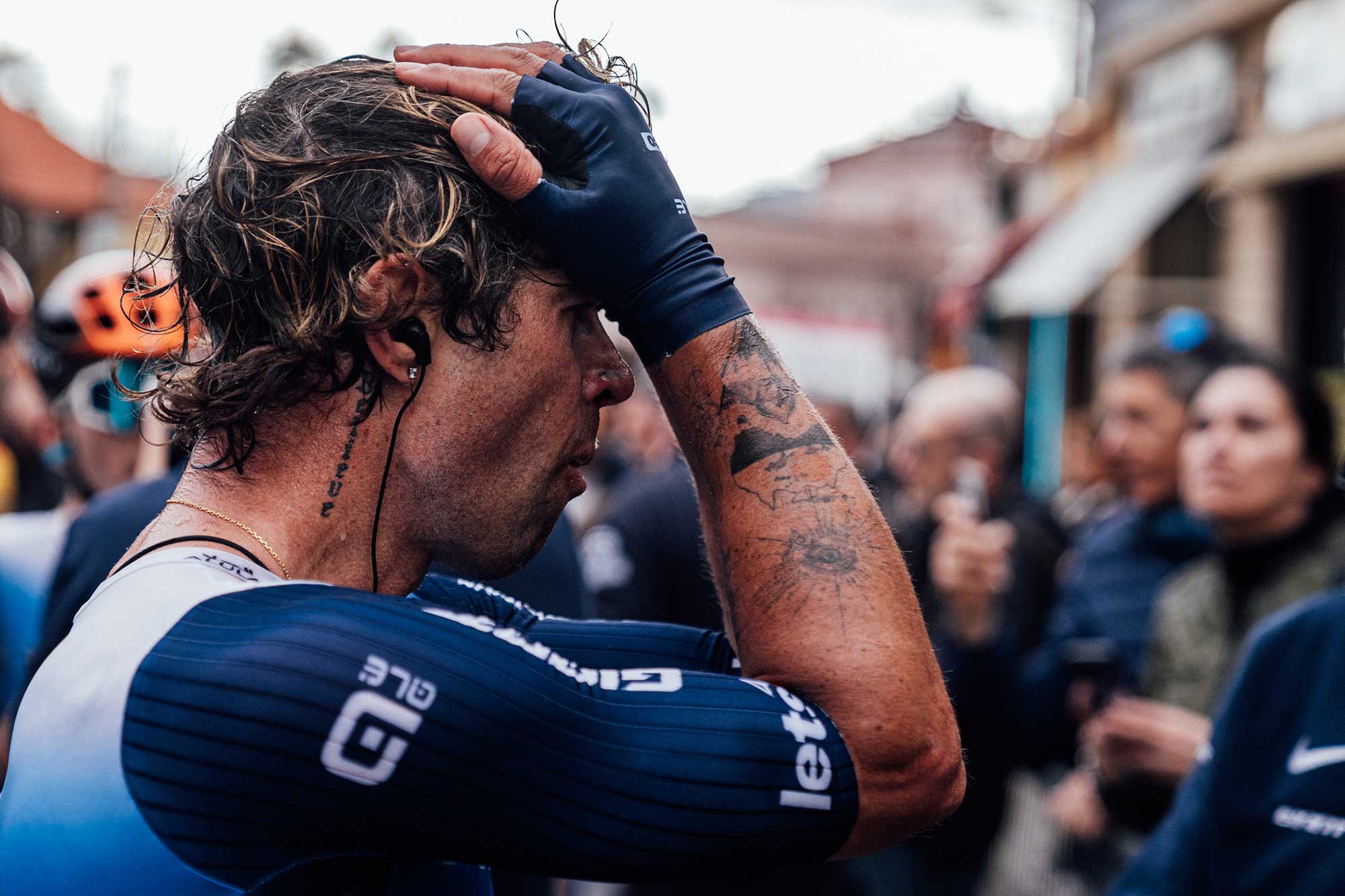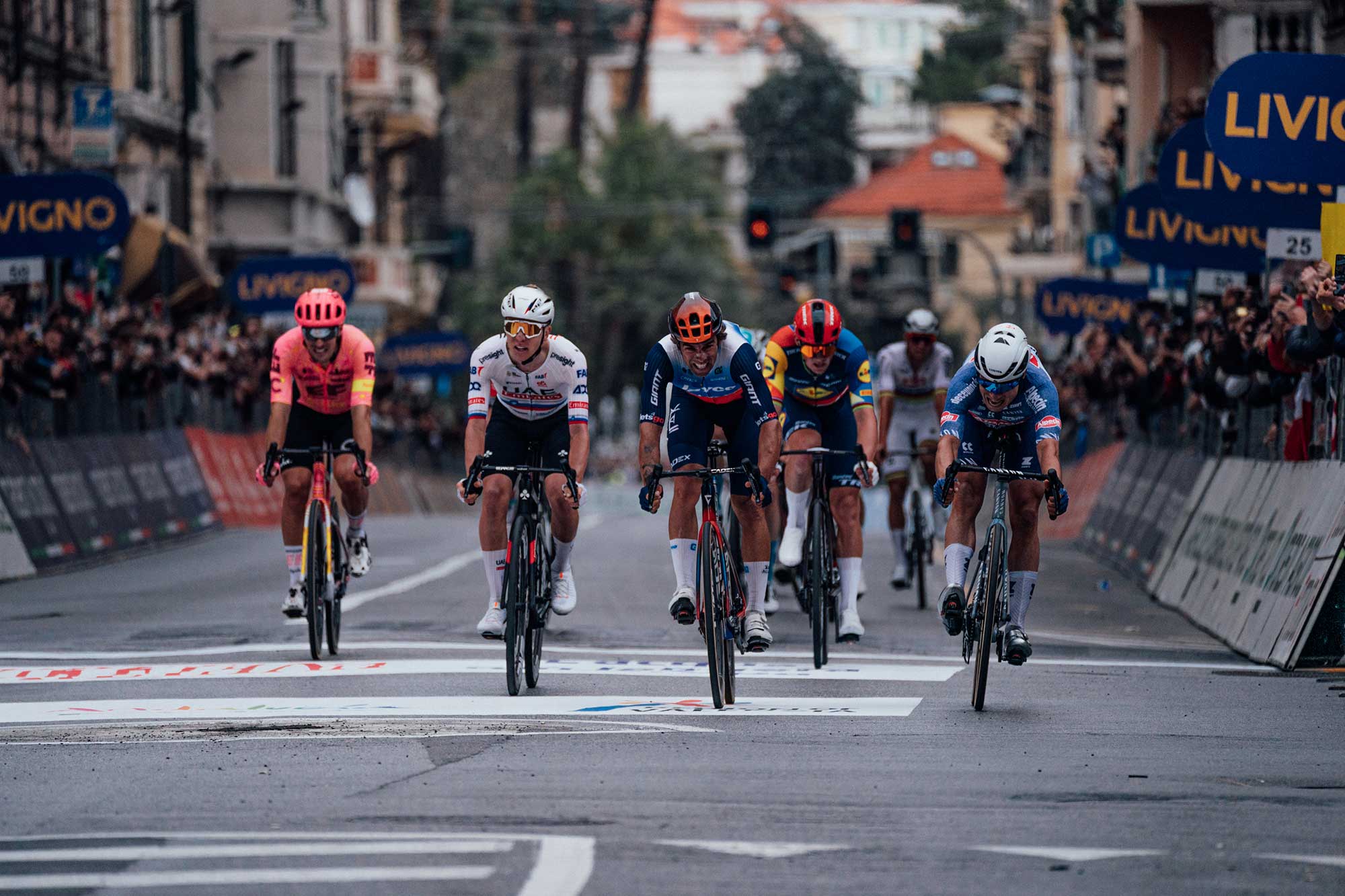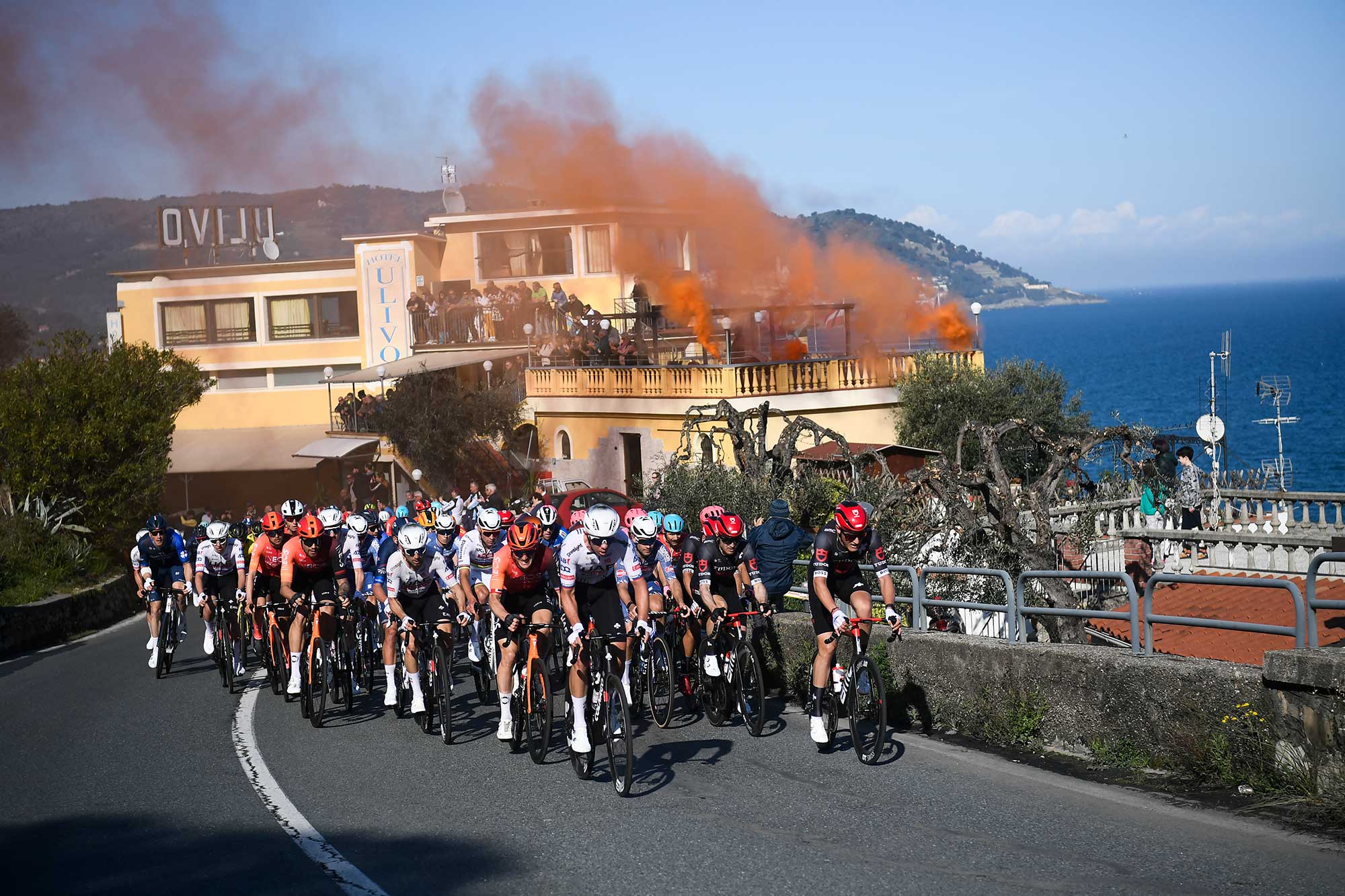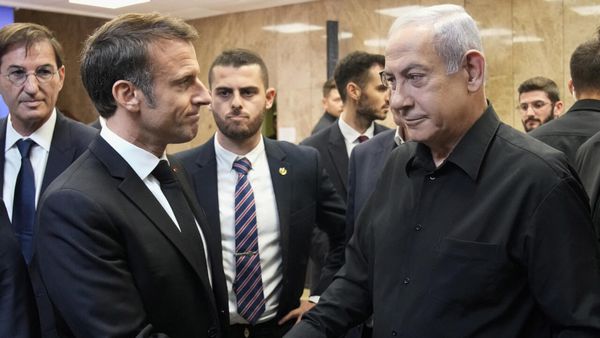
Milan-San Remo means everything to Michael Matthews. The Australian racer has vividly visualised and dreamed about crossing the line first on the Via Roma. “More times than I could say,” he tells Cyclingnews.
He has come so close to doing that in reality, too. Matthews has finished second, third twice and fourth in the year’s first Monument one-day race. With six finishes altogether in the top ten, no other rider in the WorldTour peloton has more.
Jayco-AlUla’s star sprinter-puncheur has had more than 40 wins in his career, enjoying stage wins in all three Grand Tours, and has a Tour de France green jersey hanging in his wardrobe. But pro cycling’s longest one-day race has become his white whale. Milan-San Remo suits his versatility, durability and finishing speed so well, yet its trophy has remained within reach, but tantalisingly out of his grasp.
There are so many ways to win Milan-San Remo, with a dynamic which can change in the flick of a gear level or twitch of a contender’s muscle fibre on the Poggio. Underlining how tricky the feat is, there have only been one-time champions since Matthews’ compatriot Matt Goss triumphed in 2011. Nobody has claimed back-to-back victories since German sprinter Erik Zabel in 2000 and 2001.
Matthews agrees that the marathon March event is one of the sport’s hardest races to conquer. “Because it’s so open to a lot of different scenarios,” he says. “Other classics normally come down to similar ones every year, but I think a lot of guys can get over the Cipressa and Poggio these days. There’s a mixture of sprinters, of climbers, of protagonists, so you’re not really sure exactly what’s going to happen.
“It’s a bit of a lottery, let’s say: you make your move, and sometimes it’ll pay off, and other times, it won’t. You’ve got to gamble on one decision and stick with that, hopefully it works out. It hasn’t for me yet.”
Milan-San Remo is not just another bike race or a box being casually ticked for the Australian veteran. It is a historic event which resonates on a deeply personal level for several reasons. “Firstly, I love racing in Italy. And secondly, it’s 30 kilometres from Monaco, where I’ve lived for the last 12 years. I train on those roads every single day,” Matthews says. He reckons that he has done the race’s last, finale-shaping hill, the Poggio, 100 times and knows every corner.
“It’s such a beautiful race. And I think the passion the fans have for it, being the first Monument of the season, it’s always super special to have a good result there to sort of set up the season,” he adds.
“It really suits my characteristics well. A long race and then a really crazy, hectic final: I love that stuff. Even when I talk about the race, I get tingles. I’ve been so close so many times. I would be very disappointed not to stand on the top step of the podium in Sanremo in my career.”
Sign up to the Musette - our subscriber-only newsletter
Matthews “a mess” after agonising 2024 near miss
Matthews cannot get much closer than he did in 2024. He made it over the Poggio in a dozen-strong group of favourites whittled down by several fierce attacks from his friend Tadej Pogačar. He gave his Slovenian friend a lift to the race last year, but there were to be no niceties when it came to going for glory.
Mathieu van der Poel’s presence in the group was crucial, putting a lid on Pogačar’s move and chasing down other dangerous attacks, keeping it together for Alpecin-Deceuninck teammate Jasper Phlipsen. Only that dynamic duo and Lidl-Trek pairing Jasper Stuyven and Mads Pedersen had numbers up front, able to orchestrate a lead-out.
Locked onto Pedersen’s wheel, Matthews launched his sprint and hit out in front. Philipsen followed in his slipstream and edged ahead in the last moments, winning on the bike throw by the width of a wheel rim.
“Everything looked like it was going really well until the last 25 metres when my glasses flew off, hit my front wheel and went flying up in the air. I've never seen this happen in cycling before,” Matthews said.

“Being a couple of centimetres away from winning a Monument was a hard one to swallow,” he recalls. “It took a long time, basically until the morning of the Tour of Flanders [a fortnight later] to really get over it. I think those next few races I did, my head was all over the place. I couldn't focus. I didn't really want to be at races. I was a bit of a mess, honestly.”
The manner in which he narrowly lost the race was a discussion point in the following days. Almost a year on, Matthews doesn’t believe he made a mistake by keeping a gap open on the barriers for Philipsen, who accelerated past in the last 25 metres.
“It’s one of those fine lines. I felt a little push from my hip, maybe that moved me a little bit,” Matthews said. “But I’m also not a rider that’s gonna put a guy in a barrier to win a bike race. If I did close the door, maybe he protests, and I get disqualified. I was running that fine line in that Sanremo. I wouldn’t do anything differently – apart from keeping my glasses on my head.”
When you re-watch Matthews’ sprint, he has a point. He starts in the middle of the road, carves left, following the shortest path of the road, right towards the median, then left again towards the barriers in the final seconds before straightening. Any more deviation, or pinning the Belgian fast man against the barriers, would probably have sealed his fate with the commissaires.
A supporting role for Oscar Freire
His latest result was a far cry from his Milan-San Remo debut as a neo-pro for Rabobank in 2011. At the age of 20, Matthews was the youngest competitor on hand to support Oscar Freire, a champion he'd looked up to for a long time. A three-time winner of “La Primavera”, the Spaniard was an unconventional champion, occasionally disorganised and sometimes marching to his own beat, which contributed to making the experience especially memorable for Matthews.
“I remember we were doing the team meeting the night before and we said ‘Where is Oscar?’ Nobody had seen him all day. Then he was really late for the meeting and we said ‘Where have you been?’
"He said, ‘Oh, I went for a walk into Milan; I was taking photos,’” Matthews recalls. It flew in the face of pro cycling lore: why sightsee, let alone stand, when you can sit or lie down, especially ahead of a 300-kilometre Classic?
“So this was my first experience of Milan-San Remo. Oscar was a crazy guy, so talented, but really just enjoying life. I think he crashed in that race and broke his shoe, so he had to get a spare one from the car. Then I was pacing him back, but unfortunately, we never really made it back to the front.

Never mind finishing 107th, the seeds for a career-long love affair were sown for Matthews. “It was a really special experience that I’ll never forget,” he says.
Within a few years, Matthews was contending for the race himself. His first top-10 finish came back in 2015, placing third, a few metres behind winner John Degenkolb and Alexander Kristoff. Off the back of two Paris-Nice stage wins that spring, Matthews was confident it was going to be his year.
“I messed up the sprint. I got myself into a position where I got blocked and couldn’t do my proper sprint. If you see the replay, from where I came from to where I got to, I was super fast,” he reflects.
“I think that one also haunts me until now, basically knowing I was so strong and got blocked at a bad moment and didn’t hit out when I should have. But you learn from that, hopefully you don’t make the same mistake again.”
He also finished third in 2020, best of the small sprinting pack as Wout van Aert pipped Julian Alaphilippe 25 metres up the road after their breakaway over the Poggio. So near, yet so far again.
The make-up of San Remo
The Milan-San Remo route changes very little in the modern era. The riders know the principal tests that face them and are up at the crack of dawn to carbo-load ahead of a 288-kilometre race, with over 2,300 metres of climbing on offer.
A slow edition can mean over seven and a half hours in the saddle for the bunch. It’s a tricky one to prepare for. “I try not to overthink it. It’s probably the race I’ve done the most in my career,” Matthews said. “I think you just need to switch off your brain as much as possible until it needs to turn on and really focus for the final.”
Alongside chatting with peloton pals early on, Matthews focuses on eating and drinking, getting thousands more calories on board: “There’s no real secret to it. Either you like it or you don’t, you can handle it or you can’t.
“Every time I do the race, I think back to the years before where I’ve been through every sort of weather in Milan-San Remo – snow, crazy rain, beautiful weather, pretty ok weather. I think of all those different things that have happened over the last years, sort of gather up all that information that I’ve learned from the race and try and do better every year.”
Haring south through the Po Valley, the percorso drags up Fausto Coppi’s hometown of Novi Ligure around the 90km mark before ascending its high point, the Passo del Turchino, just before the halfway mark.
After hitting the azure, alluring Ligurian coastline 10 kilometres later, it’s flats-ville until the capi, the punchy climbs on the SS1 road, which hugs the Ligurian Sea. Capo Mele, reached with 60km to go, signals the start of a hill-stuffed endgame, quickly followed by the Capo Cervo and Capo Berta.

In recent years, small groups have contested victory in San Remo, a far cry from the 40-strong pelotons we saw ten years ago. Matthews reckons a contributing factor is the capi being ridden more intensely than in the past, leading to riders being dropped there. “Every year, it just seems to be getting quicker and quicker,” the 34-year-old says.
“I don’t think it’s down to a certain person, just the way the race is evolving, where climbers are starting to feel they can get involved. When you see guys like Nibali winning the race [in 2018], I think every other punchy climber is thinking, ‘Maybe I can win.’”
Positioning at the front becomes more and more crucial for the race’s final two hills, the Cipressa and Poggio. If a wannabe winner is not in the top twenty-five positions, especially as the pace cranks up before the final climb, it is difficult to win. Any acceleration burns precious energy right before it is needed most.
Faster, still furious: how the finale’s dynamic evolved
The characteristics of Milan-San Remo’s final hour usually depends on the tactic of pre-race favourites and their teams’ manpower. Sometimes, all you need is one superstar who has the power and the well-timed solo attack (Mathieu van der Poel, 2023) or a few on-song all-rounders to make good an escape over the Poggio (Kwiatkowski, Sagan and Alaphilippe’s blanket finish in 2017 comes to mind). On other occasions, teams with hardy sprinters call the shots, possessing the numbers and desire to keep things together – such as the 2016 edition, won by Arnaud Démare won, when Katusha, Tinkoff-Saxo and Etixx-QuickStep chased and pushed for a bunch kick.
In the current era, the knowledge of needing to make the race hard for pure sprinters leads to a faster Milan-San Remo finale than ever. “I think the amount of different riders targeting the race now just makes it faster and faster. When you get to those two final climbs now, the last few years, you see UAE wanting to make it as hard as they can to drop as many people as they can to make it more suited to Tadej [Pogačar]. I’m sure that’s not going to change in the next few years.”
Fail to adapt, prepare to fail. That way of racing plays into Matthews’ hands, too. “If Philipsen wasn’t there last year – okay, maybe Mathieu would be racing for himself, it might have been a little different,” he says.

“But Philipsen is probably the fastest guy in the world at the moment and it’s difficult to beat him if he’s gotten over the climbs with a guy like Mathieu to help him. So the perfect situation for me would be as fast as possible to get rid of as many people as we can and have a more reduced sprint.”
In modern life, there can be an onus on changing things for change’s sake, sometimes catering to society’s perceived reduced attention span. Milan-San Remo might be a long, slow-burner, but its conclusion is a time-honoured treasure which is perfect as it is. The bunch goes full throttle up and down the Poggio, seeing puncheurs, climbers, Grand Tour contenders, time-triallists and sprinters going toe-to-toe.
With attacks firing away and nail-biting pursuits of escapees, it is an adrenaline flood for rider and viewer alike, 15 minutes of guaranteed unmissable sport.
Then, after a whirlwind of a day, Matthews ends up in Monaco, wondering what on earth just happened.
“Last year, my wife and daughter were at the finish line. We jumped in our little Audi A1 and drove home,” he says. “We got some delivery sushi, had that for dinner and went to bed. It was crazy: from a tyre away from winning a Monument and the dream of my life to back to reality, sort of thing.
“It was definitely a rollercoaster of emotions from crossing that finish line, even until now. I never sort of can let it go, let’s say,” he says of his second place. “That night, my wife and I were happy [with my personal effort, beating so many talented riders], but being so close, obviously it’s very difficult.”
So, made wiser by years of experience and motivated even more by his near misses, is 2025 the year that Michael Matthews finally wins Milan-San Remo?
“It's one of those races where I saw my Australian teammates win, with Matt Goss and also Simon Gerrans. So, it obviously does suit Australian riders. I'm just hoping and dreaming to be the next one to do it,” he says.
If you subscribe to Cyclingnews, you should sign up for our new subscriber-only newsletter. From exclusive interviews and tech galleries to race analysis and in-depth features, the Musette means you'll never miss out on member-exclusive content. Sign up now







